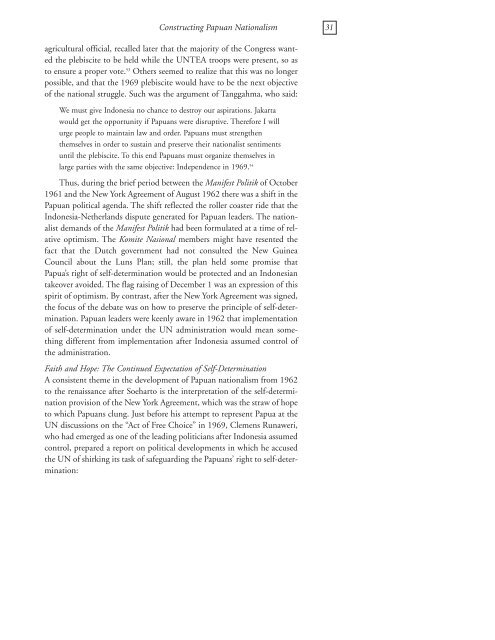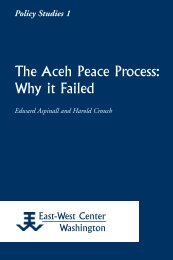Constructing Papuan Nationalism: History, Ethnicity ... - ScholarSpace
Constructing Papuan Nationalism: History, Ethnicity ... - ScholarSpace
Constructing Papuan Nationalism: History, Ethnicity ... - ScholarSpace
- No tags were found...
Create successful ePaper yourself
Turn your PDF publications into a flip-book with our unique Google optimized e-Paper software.
<strong>Constructing</strong> <strong>Papuan</strong> <strong>Nationalism</strong> 31agricultural official, recalled later that the majority of the Congress wantedthe plebiscite to be held while the UNTEA troops were present, so asto ensure a proper vote. 53 Others seemed to realize that this was no longerpossible, and that the 1969 plebiscite would have to be the next objectiveof the national struggle. Such was the argument of Tanggahma, who said:We must give Indonesia no chance to destroy our aspirations. Jakartawould get the opportunity if <strong>Papuan</strong>s were disruptive. Therefore I willurge people to maintain law and order. <strong>Papuan</strong>s must strengthenthemselves in order to sustain and preserve their nationalist sentimentsuntil the plebiscite. To this end <strong>Papuan</strong>s must organize themselves inlarge parties with the same objective: Independence in 1969. 54Thus, during the brief period between the Manifest Politik of October1961 and the New York Agreement of August 1962 there was a shift in the<strong>Papuan</strong> political agenda. The shift reflected the roller coaster ride that theIndonesia-Netherlands dispute generated for <strong>Papuan</strong> leaders. The nationalistdemands of the Manifest Politik had been formulated at a time of relativeoptimism. The Komite Nasional members might have resented thefact that the Dutch government had not consulted the New GuineaCouncil about the Luns Plan; still, the plan held some promise thatPapua’s right of self-determination would be protected and an Indonesiantakeover avoided. The flag raising of December 1 was an expression of thisspirit of optimism. By contrast, after the New York Agreement was signed,the focus of the debate was on how to preserve the principle of self-determination.<strong>Papuan</strong> leaders were keenly aware in 1962 that implementationof self-determination under the UN administration would mean somethingdifferent from implementation after Indonesia assumed control ofthe administration.Faith and Hope: The Continued Expectation of Self-DeterminationA consistent theme in the development of <strong>Papuan</strong> nationalism from 1962to the renaissance after Soeharto is the interpretation of the self-determinationprovision of the New York Agreement, which was the straw of hopeto which <strong>Papuan</strong>s clung. Just before his attempt to represent Papua at theUN discussions on the “Act of Free Choice” in 1969, Clemens Runaweri,who had emerged as one of the leading politicians after Indonesia assumedcontrol, prepared a report on political developments in which he accusedthe UN of shirking its task of safeguarding the <strong>Papuan</strong>s’ right to self-determination:
















